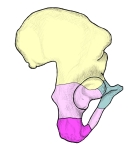坐骨上枝とは


「日本人体解剖学 (上巻) 」には以下のような解説が見られる。
」には以下のような解説が見られる。
「(坐骨上枝とは)寛骨臼に続いた薄い部分をいう。」
 「船戸和弥のホームページ」の「坐骨」の解説では「坐骨上枝/坐骨下枝」という名称は見当たらず「坐骨枝」になっている。 ⇒「坐骨の解説全文」
「船戸和弥のホームページ」の「坐骨」の解説では「坐骨上枝/坐骨下枝」という名称は見当たらず「坐骨枝」になっている。 ⇒「坐骨の解説全文」
「(坐骨は)寛骨の後下方部にあり、閉鎖孔の後方と下方部を囲む。寛骨臼の後下部とこの下方の肥厚した三角柱状部が坐骨体で、坐骨体から前内側上方へ伸びる細い扁平柱状部が坐骨枝である。」
以下は「Wikipedia」の解説文となる。
「The superior ramus of the ischium (descending ramus) projects downward and backward from the body and presents for examination three surfaces: external, internal, and posterior.
The external surface is quadrilateral in shape. It is bounded above by a groove that lodges the tendon of the external obturator; below, it is continuous with the inferior ramus; in front it is limited by the posterior margin of the obturator foramen; behind, a prominent margin separates it from the posterior surface. In front of this margin the surface gives origin to the quadratus femoris, and anterior to this to some of the fibers of origin of the external obturator; the lower part of the surface gives origin to part of the adductor magnus.
The internal surface forms part of the bony wall of the lesser pelvis. In front it is limited by the posterior margin of the obturator foramen. Below, it is bounded by a sharp ridge that provides attachment to a falciform prolongation of the sacrotuberous ligament, and, more anteriorly, gives origin to the transverse perineal and ischiocavernosus muscles.
Posteriorly the ramus forms a large swelling, the tuberosity of the ischium」
【参考になるサイト】
・イラストや写真を掲載しているサイト-Ⅰ
・イラストや写真を掲載しているサイト-Ⅱ
